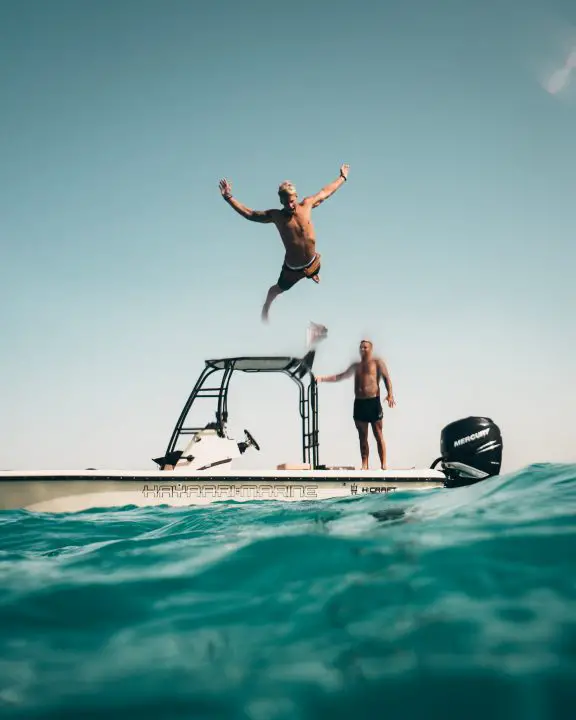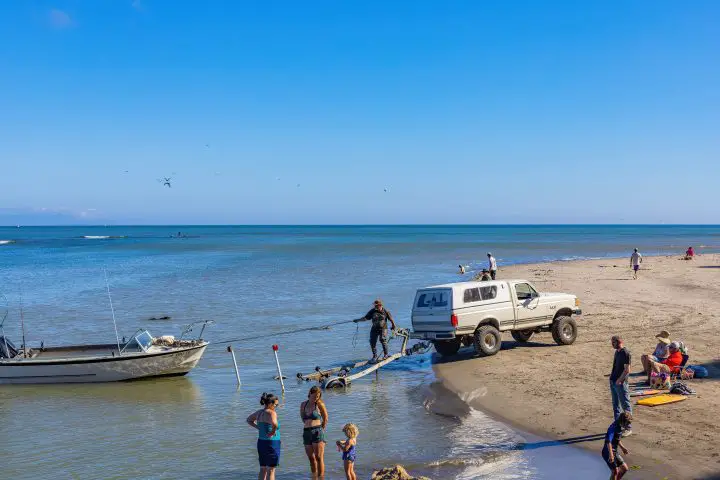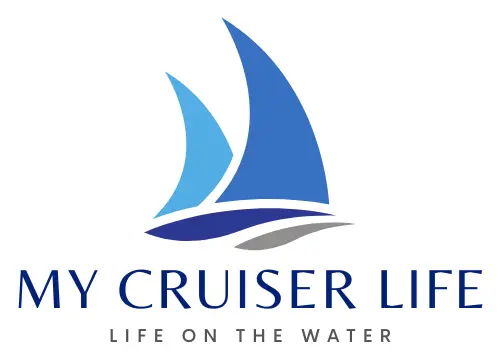While most of my blog focuses on boats you can live aboard, trailerable boats allow many people to get out on the water before they get that big boat. They’re great fun and can take you to your local lake or the Florida Keys for a week’s vacation.
Here’s a look at some critical items every boat trailer should have. I’m including the answer to “what is the main function of a boat trailer’s safety chains” and some great tips to keep you safe on the highway.

Table of Contents
- What Are Boat Trailer Safety Chains?
- The Main Function of a Boat Trailer’s Safety Chains
- What is a Boat Trailer?
- Trailer Safety Chains and Other Features of Boat Trailers
- How to Safely Connect Boat Trailer Safety Chains
- Tips and Tricks to Safely Tow a Boat
- Tow Safely Each Time By Knowing What Is the Main Function of a Boat Trailer’s Safety Chains
- Trailer Safety Chain FAQs
What Are Boat Trailer Safety Chains?
Boat trailer safety chains are a critical safety feature used when towing a boat trailer with a vehicle. These chains are designed to provide a backup connection between the trailer and the towing vehicle. Should the primary hitch or coupling device fail or become disconnected while in motion, the safety chains are intended to catch the trailer, preventing it from separating completely from the towing vehicle and causing an accident or road hazard.
The Main Function of a Boat Trailer’s Safety Chains
The main function of a boat trailer’s safety chains is to serve as a fail-safe mechanism in the event of a hitch system failure. These chains are welded to the trailer tongue and connected to the tow vehicle’s trailer hitch, ensuring that if any part of the hitch system fails, the trailer will not detach and roll away independently on the highway.
The practice of crossing the two safety chains under the hitch provides added security by creating a cradle for the hitch, preventing it from hitting the road if it becomes detached. This system acts as a critical safety measure to prevent accidents and ensure the trailer remains attached to the tow vehicle, even as a last resort.
What is a Boat Trailer?
A boat trailer is a specialized type of trailer designed to transport boats over land. It consists of a frame equipped with wheels, onto which a boat can be securely loaded, transported, and then unloaded at a destination, such as a body of water or storage facility
Why Tow Your Boat?
Towing small boats means you can go anywhere and keep them at home — saving you from paying expensive marina and boatyard fees.
Depending on where and how you boat, towing might be something you rarely do or something you do every time you hit the water.
But boat trailers are special kinds of beasts. They have their maintenance requirements—when was the last time you lubed your bearings, anyway?—and they have many steps to get rolling down the highway safely.

Trailer Safety Chains and Other Features of Boat Trailers
Boat trailers have a few key pieces of safety equipment that you should be familiar with.
The boat trailer’s safety chains are welded in place on the trailer tongue. They are connected to your tow vehicle trailer hitch as a last resort to ensure that if any link in the system fails, the trailer won’t roll off on its own down the highway.
There are two safety chains. Connect the safety chains underneath the hitch, crossed over one another. That ensures the hitch will fall on the chains, not the road below.
If your trailer has brakes, it may have a third safety chain that engages the brakes should the trailer come off the hitch.
The ultimate goal of any tow vehicle driver should be never to need their safety chains, though. Two locks on the trailer hitch should keep it attached at all times.
One keeps the hitch ball locked into the receiver. It is usually secured with a cotter pin, but you can purchase lockable trailer pins to deter theft.
The second locking pin is on the trailer tongue, where the coupler fits over the hitch ball. There’s a lock that you press down to keep it on the ball and a pin that keeps that lock held in place. Again, you can purchase lockable pins that deter trailer theft.
A good transom strap is the final towing equipment you should have for every tow. This keeps the boat connected to the trailer, even as it’s bouncing down the highway at speed. Some boats use one large strap that spans the boat’s beam, and some use two smaller ratchet straps attached to the eyes on the boat transom.
- Designed to provide excellent towing.Fit Type: Universal Fit
- Lockable offering extra safety
- Includes swiveling clip
- Includes swiveling clip
- Easy to inst
Prices pulled from the Amazon Product Advertising API on:
Product prices and availability are accurate as of the date/time indicated and are subject to change. Any price and availability information displayed on [relevant Amazon Site(s), as applicable] at the time of purchase will apply to the purchase of this product.
How to Safely Connect Boat Trailer Safety Chains
- Attach Two Chains Per Trailer – Attach one safety chain on each side of the trailer tongue connector to the hitch or chassis of the tow vehicle. Two chains provide redundant backup protection.
- Cross the Chains Under the Trailer Tongue – Loop each chain under the trailer tongue and cross them, forming an X under the tongue before attaching to the tow vehicle. This stops the trailer tongue from dropping to the road if it ever becomes disconnected from the vehicle during towing.
- Ensure Proper Chain Length – Chains should have just enough slack to allow rounding maneuvers while towing, but not too much slack that they’ll drag on the ground. As a rule of thumb, keep them tight enough to prevent any trailer-tongue to vehicle hitch contact if one comes unfastened.
- Double-Check Connection Before Towing – Physically check that the safety chain link attachments to the vehicle are secure, properly locked, and safe before every tow. Attach safety pin clips and lock where possible.
- Check Safety Chain Condition – Inspect chains for wear or damage before each trip. Replace at the first signs of corrosion, cracked links, or fraying. Ensure strength ratings match or exceed the trailer weight (check by reading the markings on each chain link).
Tips and Tricks to Safely Tow a Boat
Boat Safety Chain Basics
Cross the trailer chains and attach them to the eyes of your trailer hitch. Should any part of the hitch fail, the chains should catch the trailer tongue before it hits the road. It won’t tow well—they are a last resort to help prevent a catastrophic boating accident.
Your safety chains should not touch the road as you drive. If you hear the jingle-jangle of chains as you drive, it’s not Rudolph and Santa’s reindeer. It means your chains are too long, and you might need to adjust how you attach them. Just make sure there’s still enough slack for the trailer to turn freely.
Brake Safety
In most states, if the trailer weighs more than 3,000 pounds, it must have a brake system. Most boat trailers have surge brakes.
Surge brake systems have an extra safety chain that engages the brake if the hitch system fails. Make sure it’s attached along with your other safety chains!
Transom Straps Are Critical!
Sometimes, there’s a misconception that gravity alone will hold down a boat. Truthfully, the regular bumps a trailer goes over on the highway can make it lift off the trailer. Once that happens, it only takes a little swaying or turning movement to make a catastrophic event when the trailer returns to Earth.
To prevent this, the trailer and boat must move as one. They must be connected so that the front and back of the trailer and boat cannot come apart. The front is connected at the bow eye with the winch strap, but a robust transom strap must connect the back.
- PREMIUM RETRACTABLE TIE DOWN STRAPS RATCHET SET: Our New Stainless Steel ratchet straps heavy-duty 1 inch wide are auto retracting ratchet tie down straps and allow you to travel securely with a working load of 500lbs & a break strength of 1500lbs.
- RETRACTABLE CONVENIENCE: Our retractable boat tie downs are easy to operate. Ratchet the buckle to tighten and simply press the button to auto retract. A Patented ratchet & release design make deployment,tightening,release and transit effortless.
- COMPLETE TIEDOWN KIT: Our boat trailer ratchet tie down kit includes two 1” x 72” blue nylon & black self retracting ratchet straps to use long or short & small. Attach with optional mounting arms & 4 sets of stainless bolts, washers & lock nuts.
- STRONG RELIABILITY: Our commercial grade auto boat tiedown straps are heavy duty, high density nylon and wont stretch or lose its strength after getting wet. The cargo or transom boat trailer straps are UV-resistant and wont curl over seasons.
- WHY BETTER BOAT: We are a family owned American business committed to making premium products including boating accessories, RV care, Jet Ski & boat cleaning supplies. We stand behind our rachet straps & marine grade boat trailer accessories.
Prices pulled from the Amazon Product Advertising API on:
Product prices and availability are accurate as of the date/time indicated and are subject to change. Any price and availability information displayed on [relevant Amazon Site(s), as applicable] at the time of purchase will apply to the purchase of this product.
Mind Your Gross Vehicle Weight Rating
Please pay close attention to the GVWR of your towing vehicle and the trailer itself. It can often be difficult to pin down your precise towing weight, so be conservative. Don’t forget to add fuel in the boat’s tank (6 pounds per gallon) and water if it carries onboard water (8 pounds per gallon). Owner gear can add up to at least a few hundred pounds on most vessels.
Outboard Positioning—Up or Down?
There are two things to consider when towing an outboard boat. You can tow it with the engine tilted up or tow it with it in the fully down position. The right answer for you will depend on how much clearance the prop skeg has with the road. You don’t want your lower unit scraping along the pavement at every bump.
But many engine manufacturers will tell you that their motors aren’t designed to be towed with the engine tilted up. This puts a lot of force on the hydraulic tilt unit as the heavy motor bounces up and down. It’s not designed to take that.
If you can’t tow with the motor down, and you can’t tow with it tilted up either, what’s a boater to do? Thankfully, several brackets on the market support the motor in the tilted position for towing. This takes the stress off the hydraulics and keeps your lower unit safely off the pavement.
- Transfers weight from transom to trailer
- Angled V-block for positive alignment
- Includes hold down strap and hooks
- Some assembly required
Prices pulled from the Amazon Product Advertising API on:
Product prices and availability are accurate as of the date/time indicated and are subject to change. Any price and availability information displayed on [relevant Amazon Site(s), as applicable] at the time of purchase will apply to the purchase of this product.
- NEW DESIGN! Fits most motors as long as there are 2 TRIM CYLINDERS
- Comes with Two Red Hydraulic Steering Stabilizers Included for Trailering and an Allen Wrench so that the motor will not rotate side to side while trailering.
- There are some boats that will sit to low to the ground while being trailered, resulting in not being long enough with this product in use. It is unclear as to if there are certain brands of boats or certain lengths that cause this. If this becomes an issue for you, we can make longer extensions that could help this issue. If there are any questions please contact us.
- It is constructed from unbreakable UHMW material and a high impact rubber top. This motor holder is the affordable way of reducting the risk of damaging your motor while on the move
- No More Grease and Grime
Prices pulled from the Amazon Product Advertising API on:
Product prices and availability are accurate as of the date/time indicated and are subject to change. Any price and availability information displayed on [relevant Amazon Site(s), as applicable] at the time of purchase will apply to the purchase of this product.
Here’s a great video from Boats.com that covers the basics of safely towing a rig on the highway.
Tow Safely Each Time By Knowing What Is the Main Function of a Boat Trailer’s Safety Chains
Towing a boat is fun and allows you to access watery adventures anywhere you can drive. But towing takes practice, and there are a lot of new skills to master. Using a hooking-up checklist is a good idea until you have the basics of a safe towing setup down pat.
For more boat safety:
Trailer Safety Chain FAQs
Why do you cross the safety chains on a trailer?
When the chains are crossed, the hitch will be caught should any one component fail. If the chains are not crossed, the hitch would fall to the road, and complete loss of control of the tow vehicle is possible.





